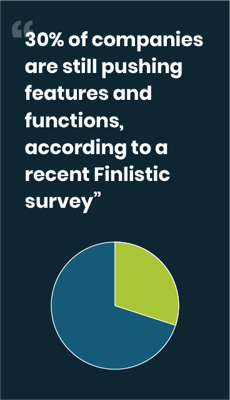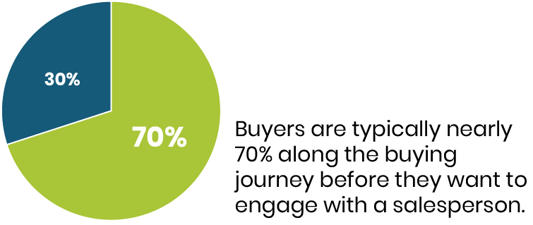Communicating a solution’s value proposition to a customer requires building a narrative that addresses your customer’s top priorities and describes potential financial benefits. Simply covering the solution’s features and functions has long been inadequate. Because buyers are more informed on available products and services than in the past, your sales team’s tactics must evolve.

EVERYTHING STARTS WITH DOING THE HOMEWORK
In highly competitive markets in uncertain economic conditions, your salespeople must differentiate themselves from the competition. By doing more homework and using robust enablement tools, they need to gain an intimate understanding of the customer’s environment, needs, and goals.
As a sales leader, you must emphasize the necessity of clearly laying out the financial and operational benefits early in the process. But your personnel cannot lose sight that the numbers are only part of a compelling narrative, not the whole story, regarding how your solution aligns and addresses the prospect’s priorities.

How Do I Start Building a Strong Value Prop?
Most businesses struggle to create a value proposition that is impactful and relevant to their customers at every stage of the buying journey. The recipe for a well-formed value prop directly addresses your customer’s business problem and delivers to them a remedy in the form of your company’s solution.
Building powerful value propositions is the most effective way for your sales team to win deals. In addition to improving close rates, a strong value prop can yield more revenue faster as you focus on delivering greater value versus simply lowering the price.
Three Steps to Building a Stronger Value Prop

Today’s buyers are upending the previous assumptions about the stages of their journey. Their internal research has likely yielded abundant information, and they will have probably progressed deep into their buying journey when they initially engage with your team.
So, the job of your sales personnel is not telling the customer something they already know - but delivering a compelling story on how your solution aligns with their top priorities. Below are the three components of building a robust value proposition across the customer’s journey.

The customer's overall goals are important, but for their key stakeholders in the decision process, they are likely also seeking to improve their own group’s metrics. Your team needs to understand each of these decision-makers’ strategies, goals, and critical initiatives.
Many salespeople fall back on using a general value proposition and expect it to appeal to all stakeholders. Next to losing the deal outright, the next worst outcome in a client meeting is to get “sent down the hall” because the pitch does not align with their objectives, and they view it as another group’s needs.
2. Articulate how the proposed solution aligns with the customer’s operational and financial goals.
To start off, below are the two fundamental questions that your salespeople need to answer in this step:
- How does my solution address the customer’s operational and financial goals?
- How does the solution help drive their crucial metrics, impact operational KPIs, and roll up to key financial goals?
A wealth of resources are available to learn about buyers’ strategies, initiatives, and goals. For example, videos of executives speaking at industry events, interviews, and the annual report’s “Letter to the Shareholders” are readily accessible resources. These resources and a host of others provide the opportunity before the first meeting to gain a solid overall picture of your customer’s needs and goals.
3. Clearly Define the Financial Benefits
The last step is often overlooked by many teams - showcasing to the customer the financial benefits. Instead, they focus on features and functions or the qualitative benefits of the solution. Your team must align with how the customer measures success; describe how your company can help them address their top challenges, and how your solution will lead to improved KPIs.
Too many salespeople get tied up trying to have all the customer’s relevant metrics before presenting financial benefits. This approach does not work. The customer does not have the time and is looking for your sales team to provide the information.
But how does your team do this if they do not have the customer’s necessary metrics? The next best thing to the client’s actual metrics is industry benchmarks. Alternatively, or in conjunction, your team can also utilize benefits your company delivered to similar companies.
Your team's educated estimates will likely be, at best, 50% accurate, and many sales leaders think even 40% accurate is a satisfactory level. The intent is to start the conversation and show the customer you have done the homework to understand their business. Most buyers will respect the attempt and be willing to share necessary adjustments to the assumptions to align with their reality.
No Shortcuts to Stronger Value Props
For sales leaders, especially in uncertain economic times, getting your team out of old habits is challenging. But there are no shortcuts to consistently winning deals.
Along with strong enablement tools, sales teams must make the extra effort to reap the rewards in an increasingly complex and competitive selling environment. Demonstrating to the stakeholders that they have taken the time to understand how the solution aligns and benefits the buying organization goes far in differentiating your business from the competition.
Empower Your Sales Team with FinListics
For additional insights on developing powerful value props, please watch our webinar “How to Build a Strong Value Prop Across the Customer Journey”, which featured:
- Justin Honaman - Head, WW Retail and Consumer Goods GTM, AWS; also hosts the podcast ContenderCast
- Ty Flippin - Senior Sales Executive
- Dr. Stephen Timme - President and Founder, FinListics Solutions
At FinListics, we specialize in helping sales leaders provide their teams with the tools and structure necessary for success. We offer a business-insights-as-a-service platform along with executive-led learning and development workshops for a complete toolset. Our experienced professionals help sales executives around the globe empower and equip their teams to win. Please get in touch with us today to speak with one of our experts.

